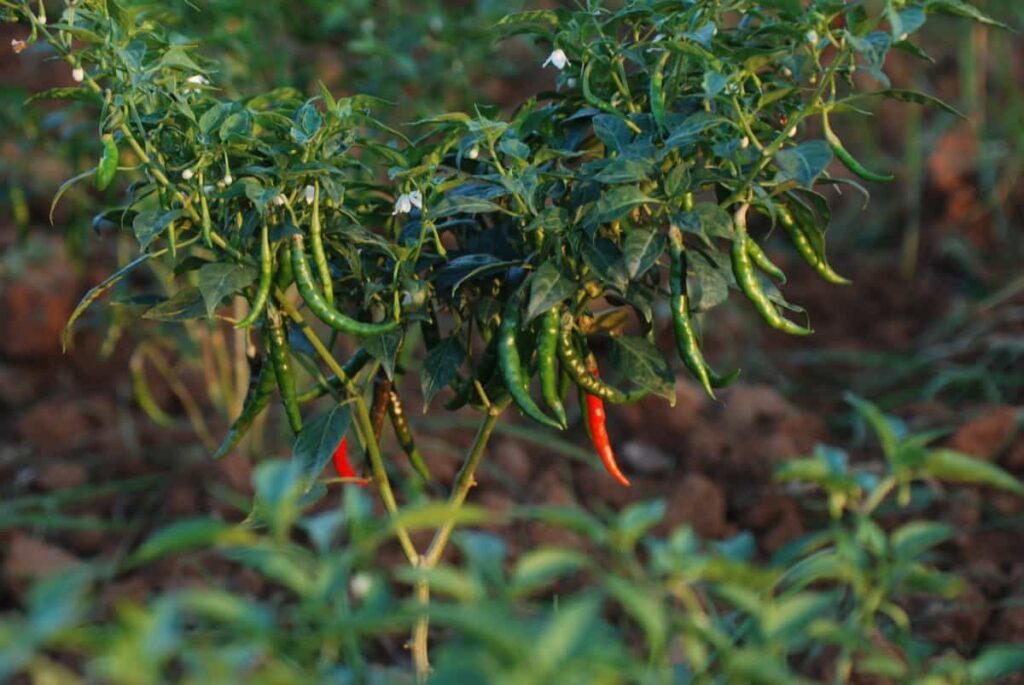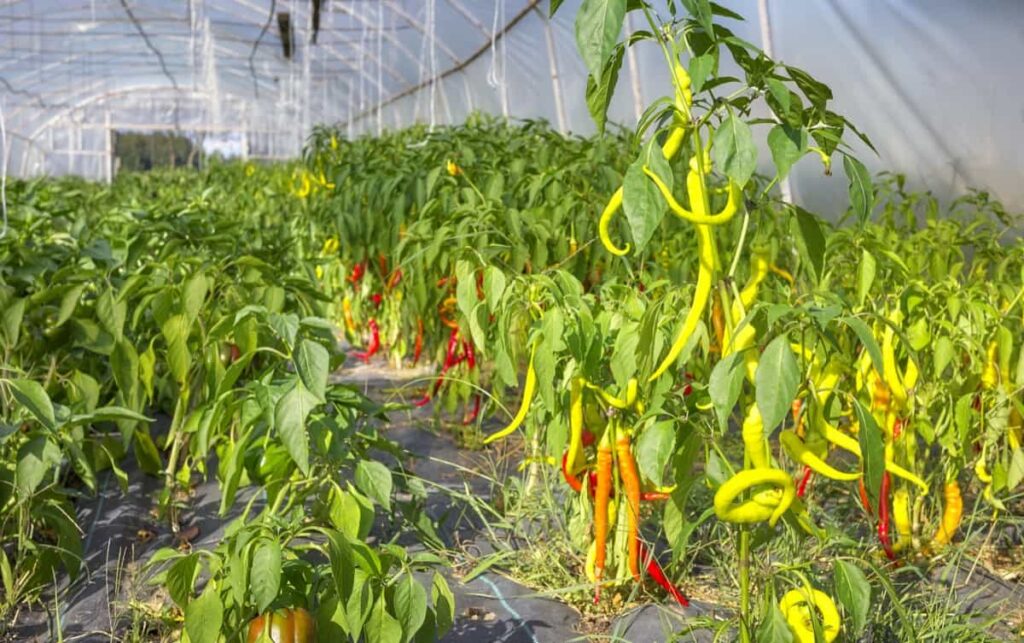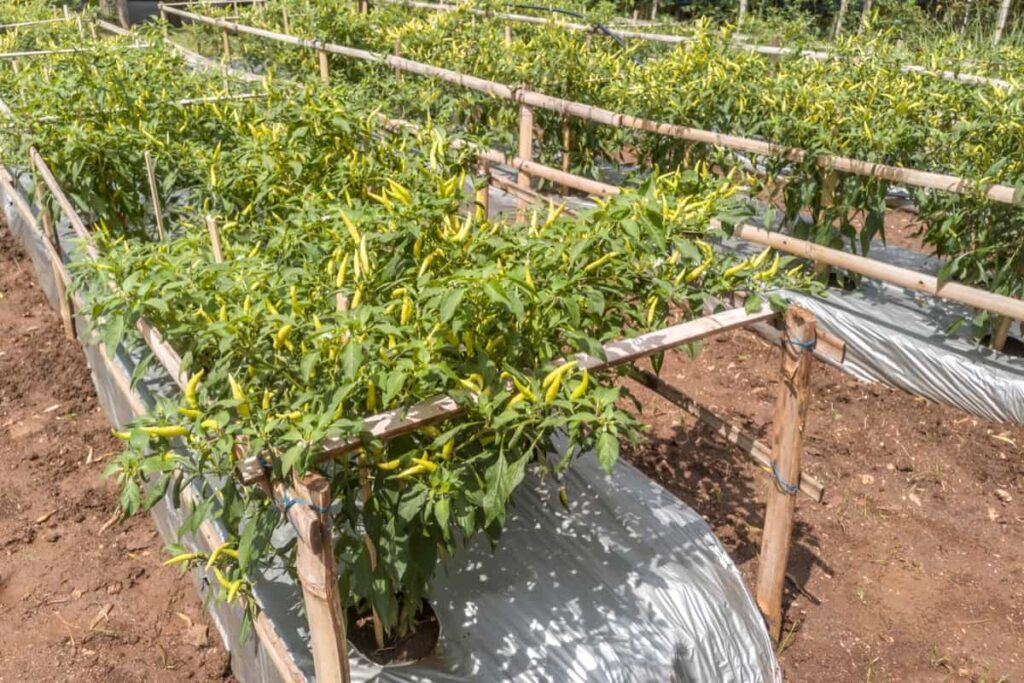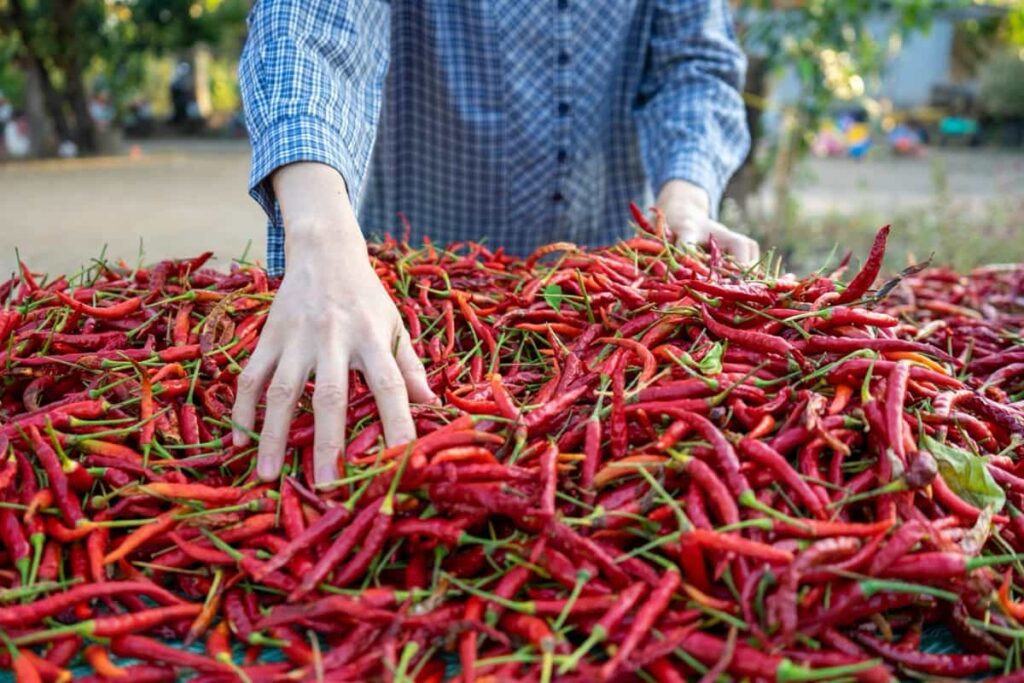Chilli cultivation in India involves varying costs across states. This exploration reveals state-specific average expenses, considering factors like seed, labor, and irrigation. The data highlights the diverse agricultural practices and economic scenarios impacting chili farming in India.

Chilli Pepper Cultivation Cost
Overview of Chilli Cultivation in India
India has the distinction of being the foremost global producer and exporter of chilies. Therefore, its wide and varied agricultural zones make it an important place for chili growing. The primary growing locations for chilies include portions of Tamil Nadu, Andhra Pradesh, Karnataka, and Maharashtra. Loamy soil that drains easily is ideal for chili plants, which also like a warm, humid atmosphere.
Selecting seeds, preparing the soil, planting, and carefully controlling water and nutrients are all steps in the cultivation process. Because chili plants are susceptible to a wide range of pests and illnesses, pest management is essential. When the chilies reach the appropriate maturity, either red or green, depending on market demand, harvesting is completed. After being picked, the chilies are dried, processed, and sold both locally and abroad.
Land Preparation Costs for Chilli Cultivation
Land preparation is one of the important steps in chilli cultivation. It involves plowing, leveling, and adding organic matter to the soil. The cost of land preparation depends on the type, size, and condition of the land, as well as the availability of labor and machinery. The average cost of land preparation for chili cultivation in India was Rs. 1500 per acre. This included the cost of plowing, harrowing, and leveling.
The cost varied depending on the size of the farm.Land preparation is essential for ensuring good soil health, weed control, moisture retention, and nutrient availability for chilli plants. It also helps in creating a favorable environment for seed germination and transplanting.
Cost of Seed and Planting Material
The cost of seed and planting material for chili cultivation depends on the variety, source, and quality of the seeds. According to various sources, the seed rate for chili cultivation ranges from 2kg to 3 kg per acre, depending on whether the variety is hybrid or open-pollinated. The cost of seed per kg also varies from Rs. 400 to Rs. 500, depending on the availability and demand.
In case you missed it: The Carolina Reaper Pepper: Planting Seeds, Growing, and Care for Scorching Heat of the World’s Hottest Chili

Therefore, the cost of seed and planting material per acre is Rs. 5200. The seeds should be treated with bio-fertilizers and bio-pesticides before sowing to enhance germination and plant health. The seeds are sown in nursery beds and transplanted to the main field after 25-30 days.
Fertilizer and Nutrient Management Costs
Chemical fertilizers are applied in split doses during the crop growth stages to provide the required nutrients for chilli plants. The recommended dose of chemical fertilizers for chili cultivation is 100 kg of nitrogen (N), 50 kg of phosphorus (P2O5), and 50 kg of potassium (K2O) per hectare, which can cost around Rs. 4,000 to Rs. 6,000 per acre. The sources of chemical fertilizers can include urea, diammonium phosphate (DAP), muriate of potash (MOP), etc.
Micronutrients are applied as foliar sprays or soil drenches to correct any micronutrient deficiencies in chili plants. Micronutrients can include zinc, boron, iron, manganese, copper, etc. The recommended dose of micronutrients for chili cultivation is 5 kg of zinc sulfate and 2 kg of borax per hectare, which can cost around Rs. 500 to Rs. 1,000 per acre.
Irrigation Costs for Chilli Cultivation
Chilli is one of the most popular and profitable crops in India. It can be grown for both vegetable and spice purposes. However, chili cultivation also requires a good amount of water and irrigation management to ensure high yield and quality. According to some sources, the irrigation cost for chili cultivation per acre in India ranges from Rs. 6,000 to Rs. 10,000, depending on the type of irrigation system, climatic conditions, soil type, and crop variety.
The choice of irrigation system for chili cultivation depends on various factors such as availability of water, soil type, crop variety, climatic conditions, budget, and preference of the farmer. However, it is advisable to adopt modern methods like drip or sprinkler irrigation for chili cultivation. They can save water, increase yield, improve quality, and reduce costs in the long run.
Costs Associated with Pest and Disease Management
The cost of pest and disease management for chili cultivation per acre in India may vary from Rs. 2000 to Rs. 5000 depending on the type and severity of the problem, the availability and price of the inputs, and the efficacy and frequency of the application. However, by following good agricultural practices and integrated pest and disease management strategies, farmers can reduce the cost of cultivation and increase the yield and quality of chili.
Labor Costs in Chilli Cultivation
The labor cost is one of the major components of the total cost of chili cultivation, as it involves various operations such as land preparation, sowing, transplanting, weeding, irrigation, plant protection, harvesting, and drying. The labor cost varies depending on the availability and wages of laborers, the size and type of farm, and the level of mechanization. According to some studies, the labor cost per acre of chili cultivation in India ranges from Rs. 15,000 to Rs. 30,000, depending on the above factors.
In case you missed it: How to Grow Jalapeno Peppers from Seed: A Step-by-Step Guide for Types, Seed Germination, and Planting

Machinery and Equipment Costs
| Machinery/Equipment | Cost Range (INR) |
| Tractor | 4,00,000-10,00,000 |
| Power Tiller | 50,000 – 100,000 |
| Sprayer (Manual) | 1,500 – 2,000 |
| Sprayer (Power) | 10,000 – 15,000 |
| Dripper | 4,500 (per hectare) |
| Dryer (Solar) | 25,000 – 30,000 |
| Dryer (Electric) | 40,000 – 50,000 |
Post-Harvest Handling and Transportation Costs
Post-harvest handling of chili involves various operations such as harvesting, grading, sorting, packing, storing, and transporting. These operations are crucial for maintaining the quality and shelf life of chili, as well as reducing the losses and increasing the income of the farmers. The costs of post-harvest handling and transportation vary depending on the type of chili (green or red), the distance to the market, the mode of transport, the packaging material, the storage facility, and the market demand.
The total cost of post-harvest handling and transportation of green chili per acre was Rs. 18,500, which accounted for 15% of the total cost of cultivation. The major components of this cost were harvesting (Rs. 6,250), grading and sorting (Rs. 3,750), packing (Rs. 3,000), storage (Rs. 2,500) and transportation (Rs. 3,000).
State-wise Chili Cultivation Cost Per Acre
| State | Cost Per Acre (Rs.) |
| Andhra Pradesh | 37,750 |
| Gujarat | 35,250 |
| Karnataka | 36,750 |
| Madhya Pradesh | 34,250 |
| Maharashtra | 35,250 |
| Rajasthan | 34,250 |
| Tamil Nadu | 36,750 |
| Telangana | 37,750 |
Frequently Asked Questions (FAQ) on Chilli Cultivation
How Long Does It Take for Chilies to Mature and Be Ready for Harvest?
It takes around 2 to 3 months from the date of planting to harvest, depending on the variety and growing conditions.
In case you missed it: How to Grow Green Chilli Peppers Faster: Best Tips to Increase Flowering, Fruiting, and Production Yield

What Is the Best Season to Plant Chilies in India?
Chilli seeds are usually sown during warm and humid seasons, with the pre-monsoon period being ideal in many regions.
Conclusion
After analyzing the data on Chilli cultivation cost per acre in India across various states, it’s evident that production costs vary significantly. Factors such as labor, inputs, and technology play an important role in determining the overall expenditure for farmers.
- Sheep Farming Business Plan for Beginners
- Aquaponic Farming at Home: A Step-By-Step Guide
- Profitable Village Farming Business Ideas in 2024
- High-Yield Aquaculture: Fast-Growing Fish for Farming
- Effective Fish Pond Construction Techniques for Beginners
- Irrigation and Water Management in Pineapple Farming
- Blossom to Harvest: Mastering Flowering and Pollination in Papaya Farming
- Pig Fattening Essentials: From Selection to Sale for Beginners
- Raising Wagyu Cattle: A Complete Guide for Premium Beef Production
- Soil Types and Their Water Holding Capacity
- Optimizing Irrigation Schedules for Coconut Groves for Enhanced Yield
- Espresso Your Garden: Coffee Grounds for Healthier Acid-Loving Plants
- The Best Soil Mix for Snake Plants: How to Mix Your Own Snake Plant Soil
- Green Thumb Success: Expert Tips for Cultivating Greenhouse Beans All Year Round
- Bloom All Year Round: The Ultimate Guide to Indoor Hyacinth Care
- Eco-Friendly Gardening: How to Make Liquid Fertilizer from Kitchen Waste
- Ultimate Guide to Grow Anise in Pots: Explore Seed Propagation to Harvesting
- Guide to Raising Chester White Pigs: Discover Breed Facts to Growth Management
- Mastering the Elegance: The Ultimate Guide to Weeping Cherry Tree Care, Planting, and Maintenance
- Ultimate Guide to Planting Garlic in Grow Bags: Growing Strategies for Beginners
- How to Fix Spider Plant Leaf-Related Problems: Natural and Organic Remedies
- 10 Reasons Why Your Tulsi Plant is Shedding Leaves: Home Remedies and Solutions
- Optimizing Growth and Yield: The Advantages of Palm Bunch Ash Fertilizer
- Utilizing Neem Oil Extract as a Natural Pesticide for Hydrangea
- From Soil to Harvest: Various Ways in Which Farmers Can Use AI Tools
- Steps to Encourage and Induce Citrus Flowers: A Comprehensive Guide
- How to Fix Snake Plant Leaf-Related Issues: Natural and Organic Remedies
- Transform Your Garden into a Fragrant Oasis with Raat Ki Rani (Night Blooming Jasmine)
- Discover the Ideal Chicken Breeds for Philippine Farms
- How to Create a Poultry Egg Farm Business Plan for Profits
- Grow Lemon Cucumbers Like a Pro: Insider Techniques for Bountiful Yields
- Ultimate Guide to Caring for Your Pink Princess Philodendron: Tips for Thriving Variegation
- Areca Nut Profit Per Acre: Calculating Yield and Cost of Cultivation
- How Kaveri Chicken is Becoming a More Profitable Breed in Indian Backyards
- Transform Your Barn: 9 Steps to Convert a Horse Stall into a Chicken Coop
- Exploring Suffolk Sheep Disadvantages with Limitations and Challenges
- Guide to Solving Potted Lemon Tree Problems: How to Revive Lemon Tree in Containers
- Steps to Encourage Female Pumpkin Flowers: Best Strategies for More Flowers and High Yields
- Ultimate Guide to Yellow Raspberries: Exploring from Planting to Care
- Ultimate Guide to Planting Ginger in Grow Bags: Growing Strategies for Beginners
- Ultimate Guide to Growing Red Creeping Thyme: Propagation, Planting, Pruning, and Care
- Top 10 Common Peacock Plant Problems and How to Fix Them
- Ultimate Guide to Raising Naked Neck Chickens: Feeding, Egg-Production, Breeding, and Care
- Unlocking Green Growth: The Surprising Benefits of Himalayan Pink Salt for Plants
- Step-By-Step Guide to Planting Carrots in Grow Bags for a Bountiful Yield
- Nourish Naturally: 10 Best Homemade Fertilizers for Meyer Lemon Tree
- How to Successfully Grow Potatoes in Grow Bags: A Comprehensive Planting Guide
- Ultimate Guide to Planting Tomatoes in Grow Bags: Growing Tips for a Bountiful Harvest
- 10 Best Natural Pesticides for Fruit Trees: 100% Effective to Kill Bugs on Fruit Plants
- 10 Best Natural Pesticides for Weed Plants: 100% Effective to Kill Weeds
- 10 Reasons Why Your Succulents Not Blooming: Remedies and Treatment
- Ultimate Guide to Swedish Flower Hen: Raising, Egg-Production, Breeding, Diet, and Care
- Dive into Diversity: Exploring the Fascinating World of Guinea Fowl Varieties
- Beat the Heat: Ultimate Guide to Keeping Your Cattle Cool During Hot Summer Days
- Profitable Donkey Farming Business in India: How to Plan for Rearing, Raising, and Selling Milk
- 10 Reasons Why My Orchids are Not Blooming: Remedies and Treatment
- 10 Best Natural Pesticides for Vegetable Garden: 100% Effective to Kill Bugs on Vegetable Plants
- 10 Best Natural Pesticides for Indoor Plants: 100% Effective to Kill Bugs on Houseplants
- Innovative Grow Bag Cultivation for Urban Gardeners: Small Space, Big Yield
- Ultimate Guide to Serama Bantam: Profile, Raising, Diet, Egg-Production, Price, and Care
- Drone Technology for Weed Management: Smart Farming Solutions
- Expert Tips for Efficient Backyard Chicken Manure Management
- 10 Best Natural Pesticides for Hibiscus Plants: 100% Effective to Kill Hibiscus Bugs
- The Ultimate Guide to Fermenting Chicken Feed: Boost Health and Savings
- Egg Failure to Hatch: Expert Guide to Diagnosing Egg Incubation Failures
- Propagating Roses with Aloe Vera: Grow Roses from Natural Rooting Hormone
- 10 Reasons Why Your Hibiscus Buds are Falling Off: Prevention and Remedies
- 10 Reasons Why Your Chilli Plant is Not Flowering: 100% Effective Treatment and Solutions
- Hydroponic Classroom Activity Ideas: Hydroponics Lesson Plan for High School Students
